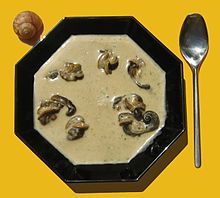Snail (food)
Some species of shell -bearing snails , like their relatives, the mussels , have been used as food since at least the Neolithic . Finds in the so-called Kjökkenmöddingern , Neolithic kitchen rubbish heaps in Denmark, are evidence of this . The Romans also appreciated them and allegedly fattened them with milk and then roasted them with spices. In poor rural Mediterranean countries, snails were a welcome addition to the diet. Snails were later a popular fasting food in monasteries because they are "neither fish nor meat" and their consumption therefore does not violate the laws of fasting. Today they are valued as a delicacy, the land-living garden snails and agate snails are the most sought-after , but there are also edible sea snails, which are counted among the seafood in the kitchen .
Land snails
Land snails can not be prepared as easily as mussels because of their mucus and their rather tough meat . To clean the intestines from plant residues, they are fed maize flour for a few days, after which they are killed in boiling water or in steam at over 100 degrees in accordance with the EU animal slaughtering regulation of 2013. They are then cleaned and cooked in a flavored broth for several hours and are finally ready for the actual preparation. Because of this great and not very pleasant effort, in Europe snails are almost exclusively pre-cooked and frozen or offered in cans.
Roman snails , also known as "Swabian oysters", have been collected in France and Italy since antiquity ; they were bred in snail gardens by the Romans . Today they come mainly from snail farms in French Burgundy , Italy, the Swiss Vaud and southern Germany . A distinction is made between the great or white garden snail (Gros bourgogne, Gros blanc, Helix pomatia ), the great gray (Gros gris, Helix aspersa maxima ) and the small gray (Petit gris, Helix aspersa ). Their occurrence is now threatened and collecting is only permitted to a limited extent. The slightly larger Turkish striped garden snails ( Helix lucorum ) are also available in stores . (Note: the correct systematic name for Helix aspersa is Cornu aspersum ).
The classic way to prepare escargots as a starter is escargot a la bourguignonne , gratinated in its own casing with snail butter , a kind of herb butter . The Baden snail soup is also known . In Germany, the preparation was also known as a salad. The cooked snails were dressed with vinegar, oil, salt and pepper. "The Italians take them out of their houses uncleaned, dip them in tree oil , and pepper them with salt."
Agate snails originally come from Africa and are also called African giant snails. They have an elongated, tapering shell, unlike Roman snails. Some Achatina species can become very large (case up to 20 cm). In Africa and the Caribbean, they are collected and bred as protein-rich food. Since garden snails have become rare in Europe, the large agate snail ( Achatina fulica ), which looks similar in terms of soft body, is often offered in the trade, usually prepared ready to cook and frozen with herb butter in the shells of garden snails.
Sea snails
Some species of marine snails are collected as seafood mainly on the French Atlantic coast, the Mediterranean Sea, and East Asia.
In Madeira and the Azores , limpets are used to prepare the traditional dish "lapas".
In Brussels, the "caricoles" are served as sea snail soup and are considered a delicacy.
The French bigorneaux (common beach snails ) are, cooked in salt water, on skewers as an hors d'oeuvre with herb butter or naturell served; in the British Isles they are called periwinkles . Are also popular in the shell cooked whelks . In Italy, mainly cornetti di mare ( spiked snails or Hercules' legs ) are offered. Sea snails are often part of Spanish paella . All types are very rarely available in Germany.
The specialties of East Asian cuisine include abalones , e.g. B. Kamchatka abalones and especially the large abalones, which are popular as sushi ingredients in Japan . They are usually eaten raw, thinly sliced, as they are easily chewy when cooked. Most abalons come from breeding facilities in Tasmania . In Europe they are only offered as canned food.
Throughout the Caribbean and in the United States are the big conch -called sea snails (Queen conch, Strombus gigas , Florida fighting conch, Strombus alatus ; Milk conch, Strombus costatus ; Hawkwing conch, Strombus raninus ) popular, such as conch salad .
References
- ↑ http://www.buzer.de/gesetz/10451/b27450.htm Killing of snails according to the EU slaughtering regulation of 2013
- ↑ Martin Cyris: Snails of the Swabian Alb: Slow Food with Schwänzle. In: Spiegel Online . November 16, 2011, accessed June 9, 2018 .
- ↑ Schneckensalat , Economic Encyclopedia by Johann Georg Krünitz, Volume 147, 1827, p. 302
literature
- Gerd Wolfgang Sievers: Snail cookbook. Leopold Stocker Verlag , 1st edition March 2005, ISBN 3-7020-1093-9
See also
Web links
- Land snail farming
- 3W Production: Snail Breeding - Article in Galileo (April 26, 2005) about Roman snail breeding and preparation
- Recipe collection for Roman snails, traditional and modern forms of preparation
- Article in the mirror about slow food



